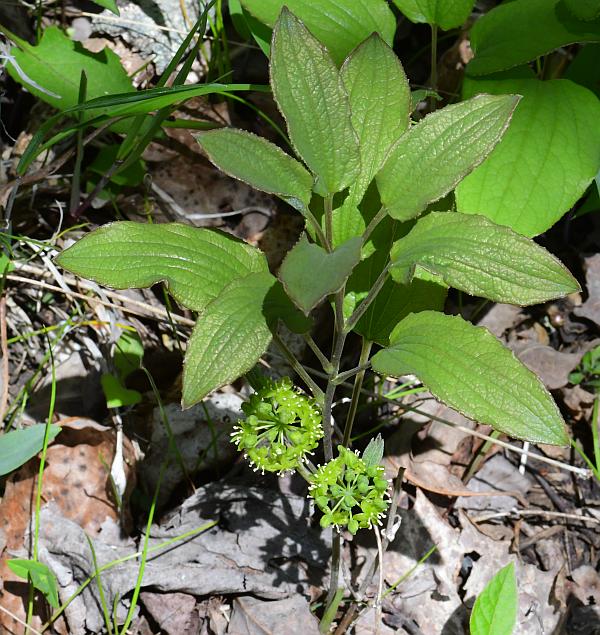Smilax ecirrhata S. Watson
Carrion Flower

Native
CC = 5
CW = 5
MOC = 35
© SRTurner
Smilax ecirrhata S. WatsonCarrion Flower | |
 |
Native CC = 5 CW = 5 MOC = 35 |
© SRTurner |
|
Family - Smilacaceae Habit - Perennial, rhizomatous, dioecious forb. Stem - Mostly erect, not climbing, 30 to 80 cm, herbaceous, lacking prickles or bristles.
Leaves - Alternate, simple, petiolate, usually 4-10 per aerial stem, those in the lower third reduced to narrowly triangular bracts, the normal foliage leaves 9-20 cm long. Petioles shorter than to about as long as the leaf blades, with few or no tendrils. Leaf blades narrowly to broadly ovate, the tips rounded, sometimes cuspidate, the bases truncate to cordate, the margins not thickened, smooth or with scattered, minute, toothlike projections, the undersurface paler than the upper surface, light green or grayish green, not shiny, the veins sparsely to densely pubescent with minute, white, flattened hairs, the network of smaller veins not thickened.
Inflorescences - Umbels, few in number, most arising from the axils of the lower stem bracts. Umbels mostly with 8-20 flowers.
Flowers - Tepals 6, in 2 series, these 3-5 mm long, green to yellowish green. Staminate flowers with 6 stamens, these free or fused at the filament bases. Pistillate flowers with 1 superior ovary with (1)3 locules, the style absent or very short, the stigmas 1 or 3, spreading.
Fruits - Berries 7-9 mm in diameter, black, usually not glaucous at maturity, with 1-6 seeds. Flowering - May - June. Habitat - Mesic forests in ravines and along the bases of bluffs, rocky stream banks, frequently climbing in thickets. Origin - Native to the U.S. Lookalikes - Other freestanding species of Smilax, especially S. illinoensis. Other info. - This is one of the smaller species of Smilax found in Missouri. It occurs in somewhat scattered form across the state but is less common in the southeastern and southwestern regions. Missouri lies near the southwestern boundary of the plant's natural range, which extends across much of the upper Midwest and into Canada. The plant is most easily recognized when in flower, by the characteristic appearance of the inflorescences; however, it can easily be mistaken for its close lookalike S. illinoensis. That species is usually somewhat taller, and has longer leaf petioles (usually at least as long as the leaf blades) and more flowers within the inflorescences. S. ecirrhata is not particularly showy and is easily missed, particularly in the case of pistillate specimens which do not have the whitened anthers to increase visibility. Photographs taken at Shaw Nature Reserve, Franklin County, MO, 5-1-2022 and 4-25-2025 (SRTurner). |